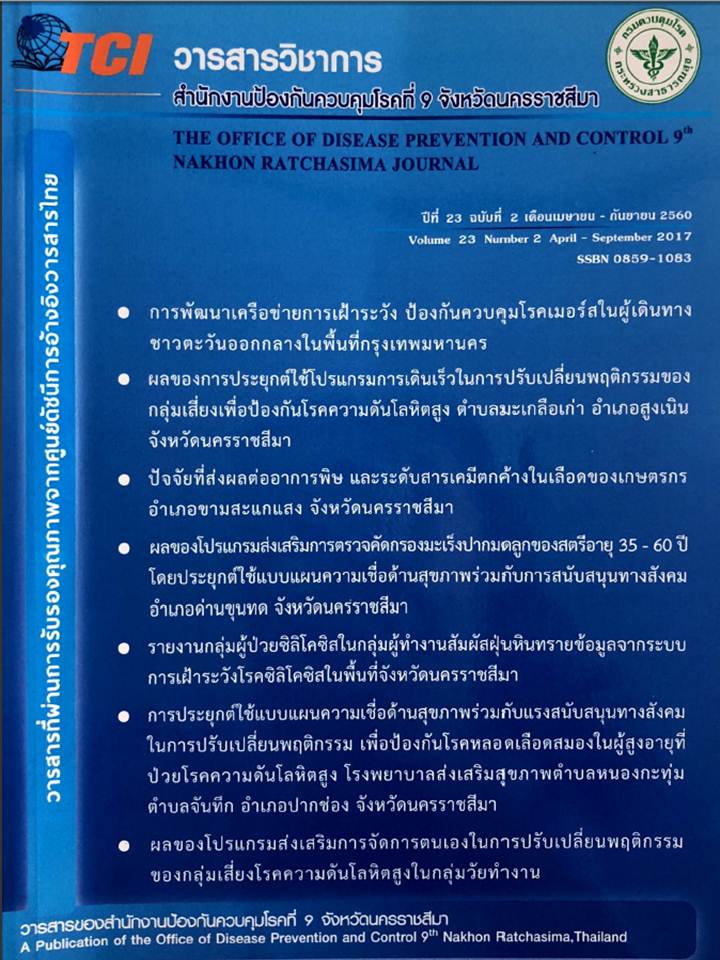An Effects of Brisk Walking Application Program on Behavioral Modi cation for Hypertension Prevention among Risk Group at Makluekao Subdistrict, Sungnoen District, Nakhonratchasima Province
Keywords:
Brisk Walking, Hypertension, Health Belief Model, Social SupportAbstract
The purpose of this research was to study the effects of an effects of brisk walking application
exercise program and behavioral modi cation mixed for behavior change hypertension prevention among
risk group. This study is quasi-experimental studied at risk of 60 persons were divided into an
experimental group and a comparison group, 30 persons each. The experimental group received
various activities such as knowledge, perception, brisk walking exercise, social support, lecture, watching
video, discussions, observing the evidence from actual model, demonstration, practice and follow-up
for 12 weeks. Data were collected by using an interviewing from June to August 2016. The gathered
data were analyzed using percentage, mean, standard deviation, paired t-test and independents t-test.
The results of the study were as follows; the experimental group showed gains in; perceptions of susceptibility,
severity, bene ts, barriers and self-behaving in food consumption; and in physical exercise at the high
level from before the experiment which were at middle level, and they indicated these outcomes more
than the comparison group (p<0.05) and risk group have blood pressure classi cation of the experimental
group after experimented decrease at the normal level from before the experimented and indicated more
than that of the comparison group (p<0.05). This study was showed, brisk walking exercise and the
application of heath belief model with social support for hypertension prevention could develop the
perceptions and self-performing behavior for disease prevention of the risk group people. Therefore,
this intervention could be effectively applied for other risk group people in other similar contexts.
References
September, 1, 2013[Internet].[ cited 2015 Oct 1] from: http://www.who.int/cardiovascular_
diseases /publications/ global_brief_ hypertension/en .
2. สำนักนโยบายและยุทธศาสตร์ สำนักงานปลัดกระทรวงสาธารณสุข. สถานการณ์โรคไม่ติดต่อ [อินเตอร์เน็ต].
กรุงเทพฯ : สำนักนโยบายและยุทธศาสตร์ สำนักงานปลัดกระทรวงสาธารณสุข; 2558 [เข้าถึงเมื่อ
1 ต.ค. 2558] เข้าถึงได้จาก: http://www.web.msu.ac.th/aboutmsu.php
3. งานควบคุมโรคไม่ติดต่อ สำนักงานป้องกันควบคุมโรคที่ 9 จังหวัดนครราชสีมา. สรุปผลงานโรคไม่ติดต่อ
ประจำปี 2558. สำนักงานป้องกันควบคุมโรคที่ 9 จังหวัดนครราชสีมา, 2558.
4. เพ็ญศรี สุพิมล. ผลของโปรแกรมสุขศึกษาเพื่อป้องกันโรคความดันโลหิตสูงของกลุ่มเสี่ยงอายุ 35 - 59 ปี
อำเภอส่องดาว จังหวัดสกลนคร. [วิทยานิพนธ์ปริญญาสาธารณสุขศาสตรมหาบัณฑิต]. ขอนแก่น :
มหาวิทยาลัยขอนแก่น ; 2552.
5. อรพินท์ สุขสกุล. การประยุกต์ใช้โปรแกรมแบบแผนความเชื่อด้านสุขภาพร่วมกับแรงสนับสนุนทางสังคม
ในการปรับเปลี่ยนพฤติกรรมเพื่อป้องกันโรคความดันโลหิตสูงของประชาชนกลุ่มเสี่ยง ตำบลตั้งใจ
อำเภอเมืองสุรินทร์ จังหวัดสุรินทร์. [วิทยานิพนธ์ปริญญาวิทยาศาสตรมหาบัณฑิต มหาวิทยาลัย].
มหาสารคาม : มหาวิทยาลัยมหาสารคาม ; 2554.
6. ทรัพย์ทวี หิรัญเกิด . ผลของโปรแกรมปรับเปลี่ยนพฤติกรรมต่อความรู้ พฤติกรรมการดูแลตนเอง และ
ระดับ ความดันโลหิตของกลุ่มเสี่ยงต่อโรคความดันโลหิตสูง โรงพยาบาลแก้งคร้อ จังหวัดชัยภูมิ.
วารสารการพยาบาลและการดูแลสุขภาพ; 31(40), 97-104. 2556.
7. สุพาภร วังคะวิง. ผลของการเล่าเรื่องต่อพฤติกรรมการเดินเร็ว พฤติกรรมการรับประทานอาหาร และ
ความดันโลหิตของผู้ป่วยโรคความดันโลหิตสูง. [วิทยานิพนธ์ปริญญาพยาบาลศาสตรมหาบัณฑิต]. ชลบุรี :
มหาวิทยาลัยบูรพา ; 2555.

Published
How to Cite
Issue
Section
License
บทความที่ลงพิมพ์ในวารสารวิชาการสำนักงานป้องกันควบคุมโรคที่ 9 จังหวัดนครราชสีมา ถือว่าเป็น
ลิขสิทธิ์ สำนักงานป้องกันควบคุมโรคที่ 9 จังหวัดนครราชสีมา



